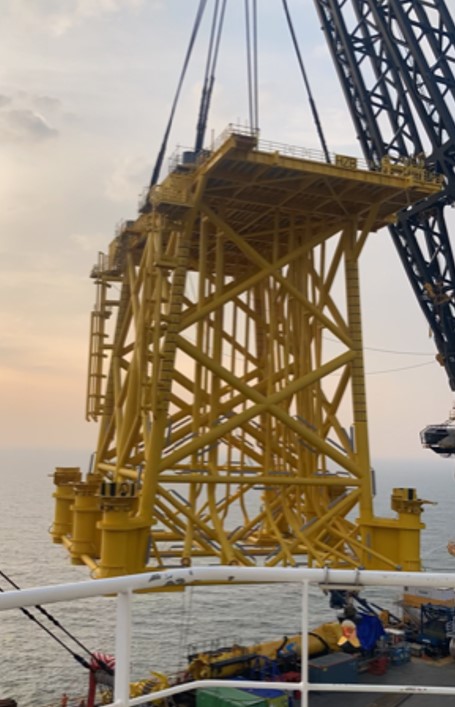LTI – ankle injury caused during lifting operations
What happened
During slewing of the crane during a jacket lifting operation the jacket started rotating. The rigging crew used a steering line in an attempt to stop the jacket rotating. During this attempt a crew member stumbled while trying to hold on to the steering line.
Two steering lines were attached to the jacket to assist with controlling jacket rotation during the lift. These steering lines were used to control jacket orientation until such times that tugger lines attached to the lift rigging could be effectively used for the remainder of the lift. After raising the jacket 3m from the deck the crane slewed to port. During slewing it became apparent that one of the steering lines was too short and had to be released. At this point the jacket started rotating. The 2nd steering line was now being used to ‘brake’ the jacket rotation however this steering line also had to be released. Before it was released, the member of the crew holding onto the line, stumbled and fell which resulted in a broken ankle and fibula.

What went wrong?
Our members investigation revealed that:
- The injured crew member was not a member of the rigging team and had crossed the barrier put in place to prevent personnel not involved in the lift operation from entering the lift path;
- One of the steering lines was too short;
- There was an alternative tugger arrangement however verification offshore showed that it was not feasible to use this arrangement owing to clashes with jacket furniture.
Preventing this happening again
- Only members of the rigging team should be actively involved in the lift;
- People who are not part of the rigging team should not assist the rigging team and should remain well clear of the lifting operation (do not cross barriers);
- Verify during Toolbox talk and last minute risk assessment that all steering lines are correct, including sufficient length;
- Ensure any tugger line arrangement made during the engineering phase is verified prior to the offshore operation.
Members may wish to refer to:
- HSSE 019 Guidelines for lifting operations
- Lifting operations (safety promotional video ‘Be prepared to work safely’)
- Lifting equipment (safety promotional video ‘Be prepared to work safely’)
Safety Event
Published: 18 August 2021
Download: IMCA SF 23/21
IMCA Safety Flashes
Submit a Report
IMCA Safety Flashes summarise key safety matters and incidents, allowing lessons to be more easily learnt for the benefit of all. The effectiveness of the IMCA Safety Flash system depends on Members sharing information and so avoiding repeat incidents. Please consider adding [email protected] to your internal distribution list for safety alerts or manually submitting information on incidents you consider may be relevant. All information is anonymised or sanitised, as appropriate.
IMCA’s store terms and conditions (https://www.imca-int.com/legal-notices/terms/) apply to all downloads from IMCA’s website, including this document.
IMCA makes every effort to ensure the accuracy and reliability of the data contained in the documents it publishes, but IMCA shall not be liable for any guidance and/or recommendation and/or statement herein contained. The information contained in this document does not fulfil or replace any individual’s or Member's legal, regulatory or other duties or obligations in respect of their operations. Individuals and Members remain solely responsible for the safe, lawful and proper conduct of their operations.
